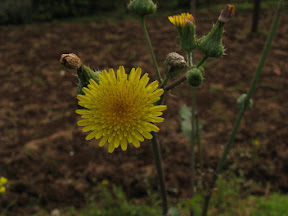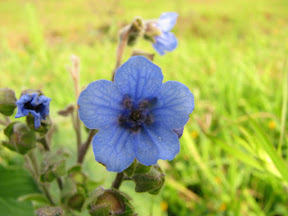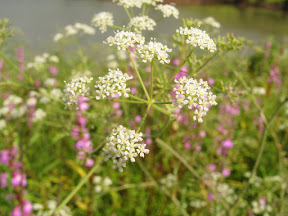Welcome. Today, we will share our experience of a visit to an important place - Raireshwara. This is the place where Shivaji is believed to have taken oath of Hindavi Swarajya.
Location and Getting There:
View Larger Map
Raireshwara is located near Bhor taluka - about 80 kilometers from Pune. Getting there is relatively easy. State transport buses ply to Bhor from Swargate stand frequently. From Bhor, we need to get some private transport (generally, shared vehicles) to Korale village. This is the most difficult part. For a larger group, this may pose challenges. To better manage time, it is best to have our own transport.
From Pune, take Satara road. Take an exit towards Bhor. In about 2 hours from Swargate, we reach Bhor. From Bhor, take a road to Ambeghar, Karanjewadi, Karnawad, Pimpalawadi, and Korale. It takes about half an hour to reach Korale village from Bhor.
This is where we begin the trek.
Trek:
Kojagiri pornima (Ashwin full moon) is the first full moon after rainy season is over in India. It is an important festival as full moon would be visible after 2-3 months during monsoon. It is celebrated by staying awake during part of the night and drinking milk after seeing reflection of full moon in it. In the recent years, due to weather changes, the rainy season is little delayed. Sometimes, it rains in October as well.
Our group had decided to celebrate the Kojagiri full moon on Raireshwara temple. On 7-Oct-2011, we set out from Swargate by state transport bus to Bhor. We were about 25-26 members. There two vehicles were arranged. Each one had capacity to accommodate 10 each. But somehow 12-13 were stuffed in each. It happens in rural India (and most of the developing countries). We reached Korale village when it was pitch dark. There were no lights at that time around. Probably another of the routine power cuts. After getting down, we arranged our sacs in the dark. Our eyes were adjusted by now. Soon after, we started to climb.
The initial road (yes, it is an unpaved motorable road) had gradual ascent. Even though the full moon was just a couple of days away, it was pitch dark due to thick clouds. Fortunately there was no mist due to warm conditions. Thanks to October heat. In between, the road had steeper ascent. We had no clue as to where we were heading. There were couple of waterfalls due to late rains. After nearly one and half hour, we reached a pass. From here, one path climbs up Raireshwara. The other descends to the other side of the mountain.
The initial few meters are scree and hence a danger of slipping. Then a gradual walk almost on level, takes to the base of steep ascent. At the end of this ascent, there is vertical rock face of around 50 meters. However, two stair cases are fixed so that it is easy for every one to visit the temple.
Here we waited for some time to regain some breath. The stairs are easy and safe. Once everyone was up on the top, then there was another long walk. to the temple. The visibility was still low. After walking for 15-20 minues, we reached the temple. There are some buildings around the temple. One school is there. Around 15-20 houses are nearby. We did not see them in the night. All us us sat down and unpacked the dinners that we carried along. It was 11 PM by now.
When lunch was finished, some of us dozed on one of the platform in the open air. Now the milk was to be boiled. So some members went around searching for dry wood. It was difficult to get it in enough quantity. At last someone found a huge piece. That alone would be sufficient.
In another 2 hours, the milk was boiled and thickened. Now there was mad rush to get the delicious milk. This milk contained some ingredients like dry fruits and custard. Whoever was asleep was awake. Fortunately, the quantity was sufficient for everybody to have enough.
Some of us slept in the temples and some in the open platform.
When I woke up in the morning, it was daylight! Still some of us were asleep. We got ready for the day. It was almost 8 AM when the group started to move. When I went inside the temple for darshan, it was closed. Through the door, the idol is visible. The core temple must have been constructed at least 2-3 centuries. There are some extensions. Of course they are not done well. There is one important stone inscription. It is partially covered by iron grill!
After having darshan, we went straight to one of the houses for breakfast. These 15-20 houses grow only rice once in a year. Everything else is brought from below. The poha (flattened rice) gave enough ammunition for us to march ahead.
Now we were able to appreciate the beauty of the nature around. There were several flowers around. Most of them are found on Kaasa plateau. Here we saw several turmeric plants. Their flowers were on the verge of drying. The entire plains gave a different perspective. At the one end of this plateau, there is Kenjalagada. There was smithia. Yellow sonaki was abundant. It was around 10 AM. After having introductions (yes. introductions were in the morning when everyone could see faces), we started swiftly to catch the bus back to Bhor.
As with any return journey, this was easier but tiring. The different flowers and butterflies made our march tolerable. Now I was wondering the flowers. While climbing in the night, I did not figure out it was so beautiful. Most of the path has Kenjalagada on one side and Raireshwara plateau on the other. The sun was blazing by now. The heat was becoming unbearable. There are not many trees on the road. Soon after we reached Korale, one bus arrived there. All of us jumped into it. Since it was starting point, we could find place for seating.
 |
| From Trek - Raireshwara Oct 11 |
Location and Getting There:
View Larger Map
Raireshwara is located near Bhor taluka - about 80 kilometers from Pune. Getting there is relatively easy. State transport buses ply to Bhor from Swargate stand frequently. From Bhor, we need to get some private transport (generally, shared vehicles) to Korale village. This is the most difficult part. For a larger group, this may pose challenges. To better manage time, it is best to have our own transport.
From Pune, take Satara road. Take an exit towards Bhor. In about 2 hours from Swargate, we reach Bhor. From Bhor, take a road to Ambeghar, Karanjewadi, Karnawad, Pimpalawadi, and Korale. It takes about half an hour to reach Korale village from Bhor.
This is where we begin the trek.
Trek:
Kojagiri pornima (Ashwin full moon) is the first full moon after rainy season is over in India. It is an important festival as full moon would be visible after 2-3 months during monsoon. It is celebrated by staying awake during part of the night and drinking milk after seeing reflection of full moon in it. In the recent years, due to weather changes, the rainy season is little delayed. Sometimes, it rains in October as well.
Our group had decided to celebrate the Kojagiri full moon on Raireshwara temple. On 7-Oct-2011, we set out from Swargate by state transport bus to Bhor. We were about 25-26 members. There two vehicles were arranged. Each one had capacity to accommodate 10 each. But somehow 12-13 were stuffed in each. It happens in rural India (and most of the developing countries). We reached Korale village when it was pitch dark. There were no lights at that time around. Probably another of the routine power cuts. After getting down, we arranged our sacs in the dark. Our eyes were adjusted by now. Soon after, we started to climb.
The initial road (yes, it is an unpaved motorable road) had gradual ascent. Even though the full moon was just a couple of days away, it was pitch dark due to thick clouds. Fortunately there was no mist due to warm conditions. Thanks to October heat. In between, the road had steeper ascent. We had no clue as to where we were heading. There were couple of waterfalls due to late rains. After nearly one and half hour, we reached a pass. From here, one path climbs up Raireshwara. The other descends to the other side of the mountain.
 |  |
Here we waited for some time to regain some breath. The stairs are easy and safe. Once everyone was up on the top, then there was another long walk. to the temple. The visibility was still low. After walking for 15-20 minues, we reached the temple. There are some buildings around the temple. One school is there. Around 15-20 houses are nearby. We did not see them in the night. All us us sat down and unpacked the dinners that we carried along. It was 11 PM by now.
When lunch was finished, some of us dozed on one of the platform in the open air. Now the milk was to be boiled. So some members went around searching for dry wood. It was difficult to get it in enough quantity. At last someone found a huge piece. That alone would be sufficient.
In another 2 hours, the milk was boiled and thickened. Now there was mad rush to get the delicious milk. This milk contained some ingredients like dry fruits and custard. Whoever was asleep was awake. Fortunately, the quantity was sufficient for everybody to have enough.
Some of us slept in the temples and some in the open platform.
 |  |
 |
 |  |
 |  |
 |  |
 |  |
 |  |
 |  |
 |  |
 |  |
 |  |
 |  |
 |  |
 |  |
In another half an hour, we got down at Bhor. We had lunch at one small hotel just outside the palace of Bhor. The lunch was delicious. After lunch, we saw the adjacent palace. This is one of the best preserved palace from Peshwe era. Currently, several movies and television serials are shot here. When we visited the palace, some shooting was already underway.
The entire trip was memorable. We visited the place where Shivaji Maharaj is supposed to have taken oath for self rule at a young age. This is where the seeds of Hindu padapadashahi was born, which loosely defines India's present boundary.
Link to wiki page
The entire trip was memorable. We visited the place where Shivaji Maharaj is supposed to have taken oath for self rule at a young age. This is where the seeds of Hindu padapadashahi was born, which loosely defines India's present boundary.
Link to wiki page
























































